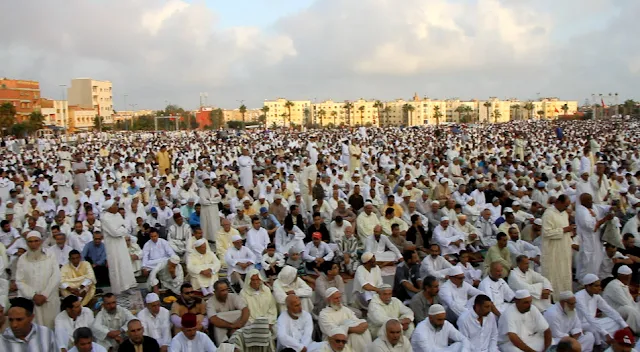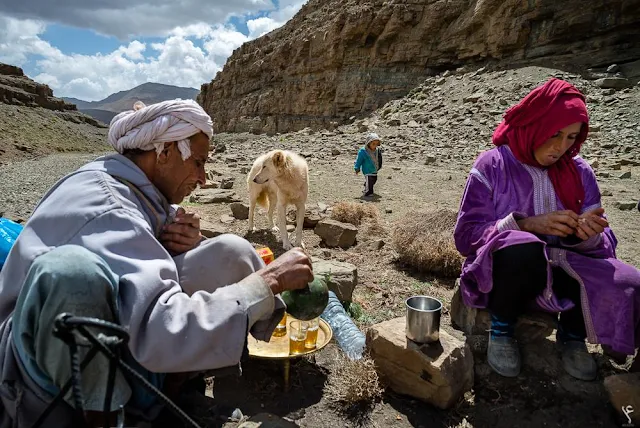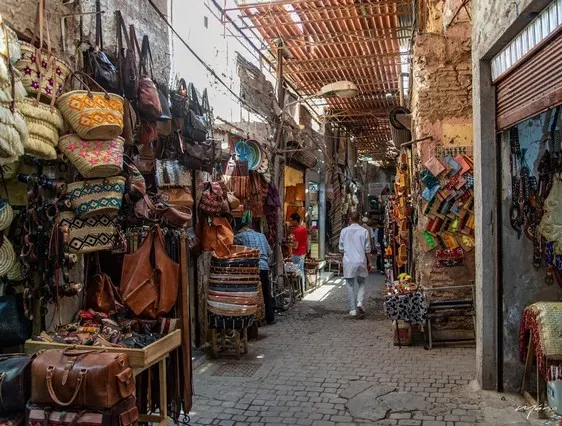Morocco, located in Northwest Africa, is a country distinguished by its
rich cultural and social diversity, reflecting its long history and the various
influences it has experienced over centuries. From the Amazigh (Berber) and
Arab cultures to European and African influences, Moroccan society represents a
model of diversity and harmony among different social components. This article
explores the various aspects of social life in Morocco, including language,
religion, education, customs and traditions, family, and popular cuisine,
backed by recent statistical and documented data.
Language
The Kingdom of Morocco is known for its linguistic diversity, with Arabic
and Amazigh recognized as the official languages according to the 2011
constitution. Modern Standard Arabic is used in administration,
education, and media, while Moroccan Arabic (Darija) is the most widely
spoken language in daily interactions. Additionally, Amazigh plays a
significant role in the daily lives of a large portion of the population,
especially in rural and mountainous areas. Amazigh is also taught in schools,
and it consists of three major dialects: Tashlhit, Tamazight, and
Tarifit. Approximately 27% of Moroccans speak Amazigh as their
mother tongue.
French is also
widely used, especially in economic sectors, higher education, and
administration, reflecting the legacy of French colonialism. Spanish and
English are also becoming more popular, particularly in northern areas
close to Spain.
Religion
Religion plays a central
role in Moroccan social life. Islam is the official religion, with 99%
of the population adhering to Islam, according to the 2014 census. and the vast
majority of Moroccans are Sunni Muslims, following the Maliki
school of Islamic jurisprudence. Islam influences
daily life and societal values, shaping customs, laws, and social interactions.
Moroccans observe religious occasions as a vital part of their daily lives.
For instance, Ramadan is a sacred month during which daily routines
change, with fasting during the day and communal iftar meals at sunset. Other significant Islamic
celebrations include Eid al-Fitr, which marks
the end of Ramadan, and Eid al-Adha, the festival
of sacrifice.
In addition to Muslims, there is a small but historically significant Jewish
community that continues to maintain its traditions, along with some Christians,
reflecting Morocco's religious tolerance and coexistence.
Education
Morocco’s education sector has seen significant developments in recent
decades, with the government working to improve education through continuous
reforms. According to the 2014 census, the illiteracy rate among the
population aged 10 and older was 32%, a high figure but a considerable
decrease compared to previous years.
The Moroccan education system is divided into three levels: primary,
secondary, and higher education. Efforts have been made to improve the quality
of education and increase school enrollment rates, with 97% of children
enrolled in primary school. Higher education has also expanded with the
establishment of new universities and institutions, such as Mohammed V
University in Rabat and Cadi Ayyad University in Marrakesh.
Customs and Traditions
Customs and traditions are an integral part of Moroccan identity. The family
holds a central place in Moroccan society, with many Moroccans living in
extended families that include multiple generations. Moroccans are known for
their strong familial bonds, with the care of the elderly and children being
the responsibility of the extended family.
Generosity and hospitality
are hallmarks of Moroccan culture, often expressed through the ritual of
serving Moroccan tea (Atay) to guests on every occasion.
Among the most significant Moroccan traditions is marriage, which is
celebrated as a major social event that often lasts several days. Moroccan
weddings are marked by vibrant colors, traditional music, and lavish feasts.
Traditional customs like henna for women and nighttime celebrations that
bring together families and friends are essential elements of these weddings.
Traditional markets (souks) also play a crucial role in daily life, offering a wide range of local
goods, from vegetables and spices to clothing and handicrafts. These markets
are not only centers of commerce but also spaces for social interaction.
Family Structure
The family is the cornerstone of Moroccan social life and plays a
vital role in the life of the individual. Many Moroccans live in extended
families, where the bond between family members is essential. Respect for elders is a deeply ingrained value, with older family members being honored and consulted in decision-making processes.
Marriage is a
central part of social life and holds a special status in society, with
weddings being large family events that require extensive preparations.
In daily life, the family serves as a social and economic support unit.
In many cases, family members work together in small businesses or agriculture,
especially in rural areas. Family occasions are opportunities to renew bonds
and express love and loyalty.
Despite the changes in Moroccan society, the core values of family
solidarity, care for elders, and nurturing of children remain deeply rooted in
tradition.
Culinary Traditions
Moroccan cuisine is one of the most famous aspects of Moroccan culture that
draws attention worldwide, reflecting the diverse cultural influences Morocco
has experienced over centuries. Dishes like tajine and couscous
are among the most well-known traditional Moroccan meals. Tajine is
slow-cooked in clay pots and typically includes vegetables, meat, or chicken,
with Moroccan spices like saffron and cumin.
Couscous is a staple
dish typically served on Fridays, the Muslim holy day, consisting of steamed
semolina grains, served
with vegetables and meat, and flavored with a broth of spices and herbs.
Harira, a traditional soup made with
tomatoes, lentils, chickpeas, and meat, is a staple during Ramadan,
often served to break the fast at iftar. Pastilla, a savory
pastry filled with pigeon or chicken and dusted with powdered sugar and
cinnamon, is another Moroccan specialty, especially during festive occasions.
Mint tea is the
national beverage, served daily in nearly every Moroccan household. It
symbolizes hospitality and is offered on family and social occasions.
Moroccan desserts often feature honey, almonds, and orange blossom water, with treats like chebakia (a fried, honey-drenched sesame cookie) and briouats (sweet or savory pastries) being particularly popular.
Traditional Clothing
Traditional Moroccan clothing is a blend of comfort and style, with the djellaba being one of the most iconic garments for both men and women. This long, loose-fitting robe, often adorned with intricate embroidery, is worn for both daily wear and formal occasions. Women also wear the caftan, especially during weddings and special events. These garments are often richly embroidered and made from luxurious fabrics like silk and velvet.
In rural areas, particularly among the Amazigh (Berber) populations, traditional dress reflects regional identities, with bright, handwoven fabrics and distinctive jewelry made from silver and coral.
Festivals and Celebrations
Moroccans celebrate a variety of religious and national holidays throughout the year. In addition to Islamic holidays such as Eid al-Fitr and Eid al-Adha, Moroccans observe Mawlid al-Nabi, the Prophet Muhammad’s birthday, with public celebrations that include prayer, music, and charitable acts.
Moroccans celebrate Throne Day on July 30, marking the coronation of King Mohammed VI.
Other cultural festivals include Gnawa Music Festival in Essaouira, which celebrates Gnawa music, a genre influenced by African rhythms and spiritual themes. The Fes Festival of World Sacred Music is another internationally recognized event that draws musicians from around the globe.
Arts and Music
Moroccan art and architecture are deeply influenced by Islamic traditions, with intricate geometric patterns, calligraphy, and tilework being central to the design of mosques, palaces, and homes. The Al-Qarawiyyin Mosque in Fes, one of the oldest universities in the world, and the Koutoubia Mosque in Marrakech are prime examples of Morocco’s rich architectural heritage.
Moroccan music is as diverse as the country itself. Andalusian classical music, with its roots in the Arab world and Spain, is a significant genre, often played during formal occasions. The rhythmic, spiritual sound of Gnawa music, with its African origins, is also highly popular, blending drums, string instruments, and chants. Chaabi music, a folk style, is commonly played at celebrations and weddings, reflecting the daily lives and emotions of the Moroccan people.
Social Changes
Moroccan society has witnessed significant changes in recent decades due to
economic, social, and political factors. Internal migration from rural
to urban areas and migration abroad, particularly to Europe, where approximately
5 million Moroccans live, have significantly impacted social life in
Morocco.
There have also been changes in activity, as Moroccan women increasingly
play key roles in the economic, political, and social spheres. According to the
World Bank, 21.9% of women were part of the workforce in 2019.
Moreover, efforts have been made to promote women’s rights, such as the 2004
Family Code.
Economic and Social Outcomes
Economically, Morocco is a diversified economy based on agriculture,
industry, and tourism. The agriculture sector remains crucial, employing
around 40% of the labor force, particularly in the production of grains,
olives, and fruits.
Tourism also plays a significant role in supporting the national economy.
In 2019, Morocco attracted around 13 million tourists, making it
one of the leading tourist destinations in Africa.
Statistics and Documentation
According to the 2014 census, Morocco’s population was approximately
33.8 million, with a 60% urban population. This figure reflects
the increasing urban migration. The youth demographic, defined as those
under 25 years of age, constitutes about 45% of the total
population.
Conclusion
Morocco's social life is a unique blend of tradition and modernity, deeply influenced by its Islamic faith, Berber roots, and historical connections with the Arab world and Europe. The family remains the foundation of society, while the country's diverse linguistic, culinary, and cultural traditions continue to thrive. This mixture of the old and the new makes Morocco a dynamic and culturally rich country, where ancient customs and modern influences coexist harmoniously.







No comments